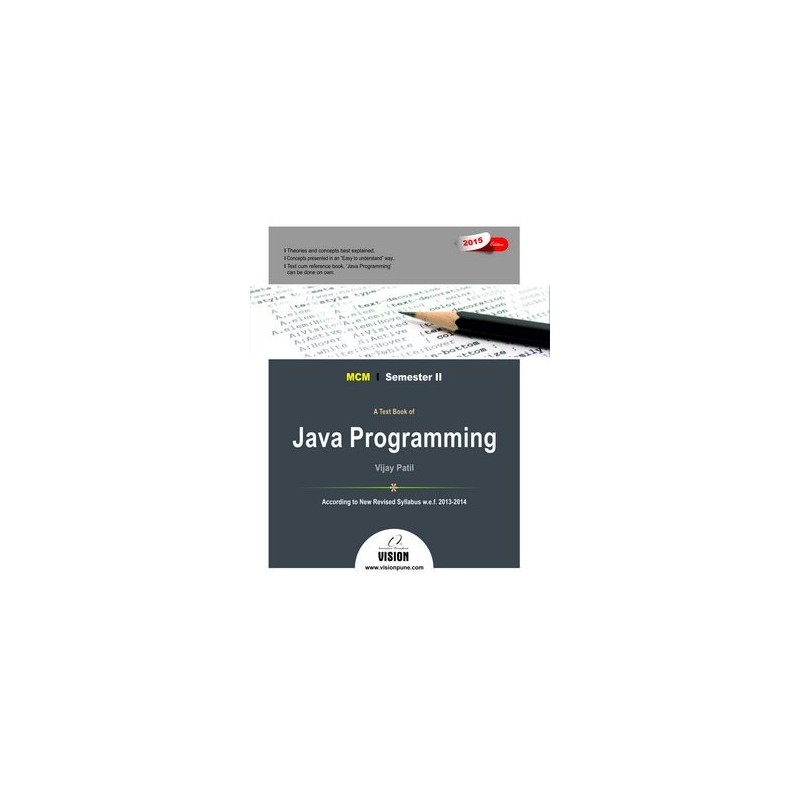Email: tovisionpune@gmail.com



According to New Revised Syllabus w.e.f. 2012 PUNE, Maharashtra (INDIA)
MCM Sem-II
Author : Vijay Patil
Book ID : 1445
ISBN : 978-93-5016-131-9
Edition : 2nd 2015
Solved Question Papers upto 2013 October
Contents
1. Fundamentals of Object Oriented Programming
1. Introduction
2. Concept of OOP
3. Structure of Procedure Oriented Programming
4. Structure of Object Oriented Programming
5. Difference between Procedural Programming and Objet Oriented Programming Language
6. Features of C++
7. Fundamentals of Object Oriented Programming
8. Advantages of Object Oriented Programming
9. Applications of Object Oriented Programming
10. Why java is not 100% object oriented language?
2. Introduction to JAVA
1. Introduction
2. History of Java
3. The Byte Code
4. Java Development Kit (JDK)
5. Java Virtual Machine (JVM)
6. Java Runtime Environment
7. Advantages of Java
8. Disadvantages of Java
3. Programming Concepts of Basic Java
1. Java Program Structure
2. Compilation and Execution of Java Program
3. Command Line Argument
4. Class Path Problem
5. Constants, Variables and Data types
6. Operators and Expressions
7. Type Conversion (Casting)
8. Operator Precedence in Java
9. Decision Making and Branching
10. Arrays
11. Array Class
4. Java Classes
1. Java Classes
2. Creating Objects
3. Differentiate between Class and Object
4. Accessing Class Members
5. Types of Classes in Java
6. Constructor
7. Constructor Overloading
8. Difference between Constructor and Methods
9. Methods Overloading
10. Nesting of Methods
11. Static
12. The this Keyword
13. Nested and Inner Classes
14. Garbage Collection
15. Wrapper Classes
16. Autoboxing and Unboxing
17. Enumerated Types
5. Inheritance
1. Inheritance: Extending a Class
2. Access Modifier
3. Abstract Class and Abstract Methods
4. Method Overriding
5. Differentiate Between Method Overloading and Method Overriding
6. Final Keyword
7. Super Keyword
8. Down Casting and Up Casting
9. Dynamic Method Dispatch
6. Packages and Interfaces
1. Introduction
2. Problem with Multiple Inheritances
3. Java Interface
4. Implementing Interfaces
5. Accessing Interface Variables
6. Similarities between Classes and Interfaces
7. Differentiate between a Class and an Interface
8. Java Packages
9. Java API Packages
10. Using System Packages
11. Static Import
12. Package Visibility
13. Adapter Classes
7. Exception Handling
1. Java-Managing Errors And Exceptions
2. Exceptions
3. Exception Handling Mechanism
4. Throws
5. Difference between throw and throws keyword
6. Finally Statement
7. Throwing User Defined Exception
8. Nested Try Statement
8. Multithreading
1. Introduction
2. Java Multithreaded Programming
3. Java Thread
4. Main Thread
5. Creating Threads
6. Life Cycle of a Thread
7. Using Thread Methods
8. Thread Priority
9. Synchronization
10.Thread Scheduler
9. Abstract Window Toolkit
1. Abstract Window Toolkit
2. Why Abstract Window Toolkit?
3. Java.awt Package
4. AWT Classes
5. Components
6. Container Class
7. Layout Managers
8. Event Handling
9. Delegating the Event
10. Event Sources
11. Event Listeners
12. Event Classes
13. Event Listener Interfaces
14. Handling Mouse Events
15. Handling Keyboard Events
16. Anonymous Inner Classes
10. Swing
1. Introduction
2. Java Foundation Classes
3. JFC Technologies
4. Features of Swing
5. Difference between Swing and AWT
6. Pros and Cons of Swing
7. Swing Components
8. Java Swing Packages
9. Swing Basic Containers
10. Working with Swing
11. Applets
1. Introduction of Java-Applet
2. Types of Applets
3. Differentiate between Applets and Application
4. Creating an Executable Applet
5. Steps involved in Developing and Testing in Applets
6. Running the Applet using Appletviewer
7. Adding Applet to the HTML file
8. Applet Structure and Elements
9. Applet Class
10. Applet Life Cycle
11. Applet Skeleton
12. Applet Tag
13. Aligning the Display
14. Designing a Web Page
15. Common Methods used in Displaying the Output
16. Displaying Numerical Values
17. Getting Input from the User
18. Update() method
19. Repaint() method
20. Status Window
21. getDocumentBase() and getCodeBase()
22. How to use an Audio Clip
23. Java – Graphics Programming
24. Using Control loops in Applets
25. Drawing Bar Charts
26. Line Graph
27. The Color Class
28. Using Fonts with Applets
12. Java Utility Packages
1. Hashing
2. Vector
3. Differentiate between Array and Vector
4. Math Class
5. Enumeration
6. Iterator
7. System
8. Random
9. String Class
10. StringBuffer Class
13. Streams and File
1. Introduction
2. Java.io.File Class
3. Java Stream Classes
4. Byte Streams Class
5. Character Stream Class
6. Difference between Byte Stream Classes and Character Stream Classes
7. Differentiate between Input Stream class and Reader Class
8. Differentiate between Output Stream Class and Writer Class
9. File Streams
10. FileInputStream and FileOutputStream
11. DataInputStream and DataOutputStream
12. BufferedReader and BufferedWriter Class
13. FileReader and FileWriter class
14. PrintWriter
15. Filter Streams
16. PushbackInputStream
17. Pipe Stream
18. RandomAccessFile
19. StreamTokenizer
20. File Operations
21. Serialization and Deserialization